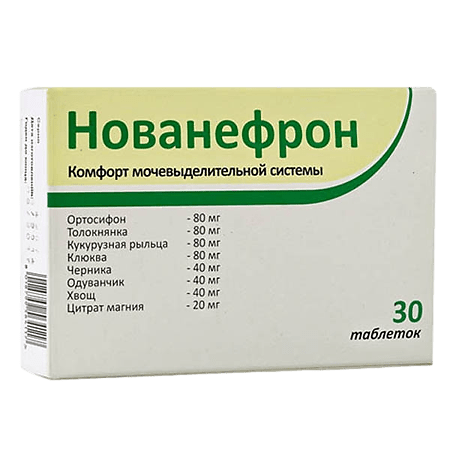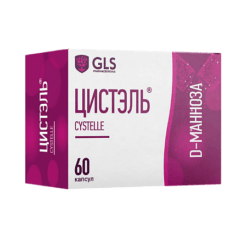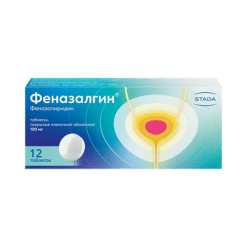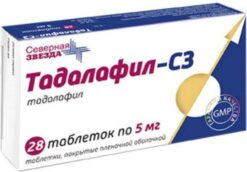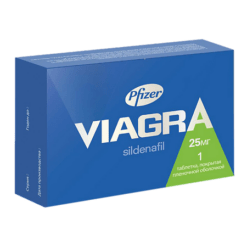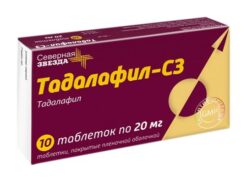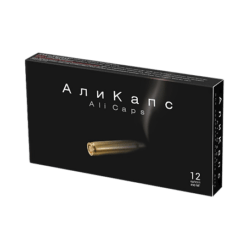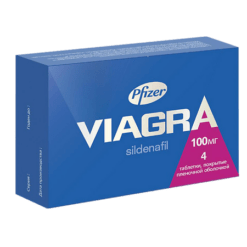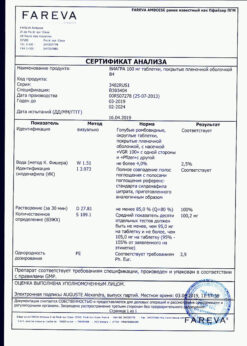No products in the cart.
Novanefron, tablets 650 mg 30 pcs.
€1.00
Out of stock
(E-mail when Stock is available)
Description
Orthosiphon stamen (orthosiphon stamineus benth). Leaves of Orthosiphon contains glycoside orthosiphonin (0.01%), alkaloids, fatty oils (2.7%), tartaric acid (1.5%), citric acid, essential oils (0.2 – 0.66%), saponins, after saponification of which α-amyrin, β-sitosterol and tannin are released. In medicine, preparations of Orthosiphon are used as a diuretic in acute and chronic kidney diseases, accompanied by edema, albuminuria, azotemia and renal stone disease. The diuretic effect is accompanied by increased excretion of urea, uric acid and chlorides. Orthosiphon increases the secretion of gastric glands and free hydrochloric acid. Orthosiphon is low-toxic, has a wide range of therapeutic action and with long-term use it does not cause any side effects.
The common bearberry (Arctostaphylos uva-ursi L.). The leaves of bearberry contains flavanoids (quercetin, isoquercetin, myricitrin, hyperoside, mirecetin), organic acids (malic, protocatechic, formic), tannins of the pyrogallum group, glycosides arbutin and methylarbutin. All these active substances form the basis of the chemical composition of bearberry (abalone).
Halenic preparations of bearberry have anti-inflammatory, antimicrobial and diuretic properties. The anti-inflammatory effect of the drug is due to the content of a large amount of tannins. Antimicrobial properties of plants associated with a glycoside arbutin, which under the influence of the enzyme contained in the leaves of arbutase breaks down into free hydroquinone and glucose. The second glycoside, methylarbutin, during hydrolysis releases hydroquinone by cleavage of methyl alcohol. The antiseptic properties of bearberry leaves are due to the antimicrobial and local irritant action of hydroquinone which, excreted with urine, irritates renal tissue through the kidneys and increases urinary excretion.
The cranberry juice. It contains: organic acids (including benzoic acid), pectin, triterpene compounds, flavanoids, anthocyanins, catechins, tannins, vitamin C and carotenoids. Cranberries are also rich in potassium and iron. Cranberry has antimicrobial properties, including against staphylococci, streptococci, Escherichia coli, protozoa, cholera agents. Marked antifungal effect. In addition, cranberries increase the effect of antibiotics, nitrofurans and sulfonamide drugs, particularly in the treatment of pyelonephritis and gynecological inflammatory diseases. Currently, cranberries are recommended for urinary tract infections. It was discovered an interesting property of cranberry fruit extract – to counteract adhesion and sticking to the cells of the mucous membrane of the bladder bacteria, which prevents them from forming colonies. One of the components contained in the cranberry fruit, ursulic acid, has a strong diuretic effect and prevents the formation of kidney stones.
Horsetail (equiseum) is used as a diuretic, styptic, hypotensive, anti-inflammatory, antisclerotic agent. Extracted from horsetail 5-glucoside-luteolin has antimicrobial and anti-inflammatory properties. Horsetail extract optimizes water-salt metabolism and improves the condition in diseases of the urinary system. When urinary acid diathesis active substances of horsetail keep the urine in the balance between colloids and crystalloids, and thus delay the formation of urinary stones, especially oxalates. Silicon compounds of the plant play an important role in the processes of metabolism and functional activity of the connective tissue of joints and blood vessel walls.
The corn stigmas (Zea mays L – com silk). Bitter glycosides 1.15%, saponins 3.18%, fatty oils 2.5%, cryptosanthine, ascorbic and pantothenic acids, vitamin K, inositol, sitosterol and stigmasterol are found in corn stigmas. Corn seeds contain 61.2% starch, corn oil, large amounts of pentosans 7.4%, biotin, nicotinic and pantothenic acids, quercetin, isoquercetin, etc. Corn stigmas are used as a diuretic, choleretic, styptic in the treatment of cholecystitis, hepatitis, urologic diseases, urolithiasis, nephritis, edema as well as in worm infestations.
Bilberry (Vaccinium mytillus). Blueberry leaves are rich in inulin, flavonoids and anthocyanins. Their fruits contain carbohydrates, organic acids, vitamins (C, B1, B2, P, PP), carotene, a high amount of pheno acids (quinic, caffeic, chlorogenic), manganese and iron compounds. Bilberry is known as an immune-enhancing, stress-resistant, hemostatic, hematopoietic, vasodilator, astringent, choleretic and diuretic.
Dandelion (Taraxacum officinale). The roots of the dandelion contains taraxacin up to 10%, triterpene compounds (taraxterol, taraxasterol), sterols (p-sitosterol, stigmasterol), flavanoids (cosmosine, luteolin-7-glucoside), inulin 24%, fatty oils, sucrose up to 20%, proteins 15%, carotene, tannins, essential oils. Dandelion roots contain alcohols, saponins, a significant amount of protein, vitamins C, A, B2, nicotinic acid. The content of iron, calcium, manganese and phosphorus found in dandelion leaves is greater than in leafy vegetables. The roots and leaves have anti-inflammatory, choleretic, diuretic, potagenic, expectorant, antipyretic, laxative, anti-allergic and anthelmintic effects.
Magnesium citrate maintains the necessary energy level of the whole body. Recommended for muscle weakness, nervous exhaustion, general fatigue and chronic fatigue syndrome. With a lack of magnesium, potassium is eliminated from the body, which leads to fatigue, loss of energy and weakness with fever. In addition, intracellular magnesium is 80-90% in complex with ATP, which is a universal carrier and the main accumulator of energy in living cells. Magnesium keeps urine salts dissolved and prevents their precipitation. Suppresses stone formation in the kidneys, even in low concentrations inhibits crystallization. Mg ions2+ binds up to 40% of oxalic acid in the urine. Prevents precipitation of calcium compounds. Is an antidote for poisoning by heavy metal salts.
Indications
Indications
Composition
Composition
1 tablet contains:
Active ingredients:
Orthosiphon stamineus benth (orthosiphon stamineus benth) 80 mg;
bearberry juice 80 mg;
cranberry juice 80 mg;
corn stigmas (com silk) 80 mg;
horsetail (equiseum) 40 mg;
bilberry (dandelion) 40 mg;
dandelion (bilberry common) 40 mg;
magnesium citrate 20 mg.
How to take, the dosage
How to take, the dosage
When used freely by the consumer, the dosages listed on the package must be adhered to.
If the drug is prescribed by a physician, there may be a change in dosage.
1-2 tablets twice a day in the morning and in the evening.
The duration of treatment is 2-8 weeks.
Contraindications
Contraindications
Side effects
Side effects
Novanefron is usually well tolerated.
Rarely: allergic reactions, weakness.
Additional information
| Shelf life | See on the package. |
|---|---|
| Conditions of storage | Store at a temperature not exceeding 25 ° C. . |
| Manufacturer | Novator Pharma, UK |
| Medication form | pills |
| Brand | Novator Pharma |
Related products
Buy Novanefron, tablets 650 mg 30 pcs. with delivery to USA, UK, Europe and over 120 other countries.

